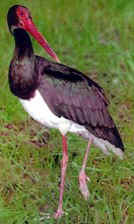Black Stork(Ciconia nigra)

Habitat: open marsh, lakes, shoals of rivers and water fields.
Feeding habits: catch fish and shrimps with its bills by quickly pecking at them in shallow water.
Food: fish, shrimps, frogs, and crabs.
Size: large-sized wading bird, with a full length of 1 m. Weight: 2500-3400 g.
Habits: it's a kind of rare migrant bird. It produces its young in North China during summer and autumn, and it flies to the South to spend winter. The birds act in groups during migration but they usually act alone at other times. In their mating season, the birds act in pairs. Black storks build their nests in cracks of stones or on big trees. Black storks produce 3-5 eggs each time. The she-bird and the he-bird raise their young together. It cannot utter cries but it can produce sounds by clapping its upper and lower bills. The number of black storks in wild state is reducing.
Category: Ave, Ciconiformes, Ciconiidae
Distribution: all around Yunnan and other places of China.
Level of protection: Class I key state protection animal of China
 
|